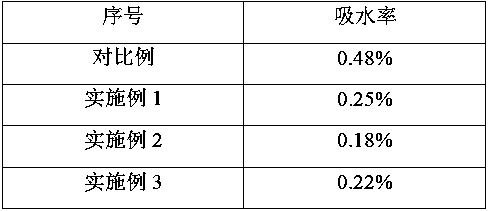A light-cured resin material for 3D printing
A technology of light-curing resin and epoxy resin, which is applied in the direction of additive processing, etc., can solve the problems of high water absorption and damage to the stability of light-cured workpieces, and achieve the effects of low water absorption, expanded use, and avoid volume expansion
- Summary
- Abstract
- Description
- Claims
- Application Information
AI Technical Summary
Problems solved by technology
Method used
Image
Examples
Embodiment 1
[0021] A photocurable resin material, wherein the mass percentages of each component are: bisphenol A type E-51 epoxy resin 51%, tricyclodecane dimethanol diacrylate 2%, trimethylol propane triacrylate 5% %, Dipropylene Glycol Diacrylate 5%, Polyacrylate Elastomer Particles 5%, 3-Hydroxymethyl-1-Oxetane 7%, 2-Hydroxymethyl Oxetane 11%, Initiator 6%, trifluoroethyl acrylate 8%.
Embodiment 2
[0023] A light-curing resin material, wherein the mass percentages of each component are: bisphenol A type E-51 epoxy resin 20%, alicyclic epoxy resin 30%, hydrogenated bisphenol A type epoxy resin 10%, 2 -Methyl-1,3-propanediol diacrylate 12%, trimethylolpropane trimethacrylate 8%, polyurethane elastomer particles 2%, 3-hydroxymethyl-1-oxetane 5% , initiator 8%, trifluoroethyl methacrylate 3%, pentafluoropropyl acrylate 2%.
Embodiment 3
[0025] A light-curing resin material, wherein the mass percentages of each component are: bisphenol A type E-51 epoxy resin 6%, alicyclic epoxy resin 20%, hydrogenated bisphenol A type epoxy resin 20%, two Propylene glycol diacrylate 7%, 1,6-hexanediol diacrylate 3%, silica particle modified epoxy resin 7%, polyacrylate elastomer particle 10%, 2-hydroxymethyloxetane Alkane 8%, 3-methyl-3-hydroxymethyl oxetane 15%, initiator 10%, pentafluoropropyl methacrylate 1%.
PUM
 Login to View More
Login to View More Abstract
Description
Claims
Application Information
 Login to View More
Login to View More - R&D
- Intellectual Property
- Life Sciences
- Materials
- Tech Scout
- Unparalleled Data Quality
- Higher Quality Content
- 60% Fewer Hallucinations
Browse by: Latest US Patents, China's latest patents, Technical Efficacy Thesaurus, Application Domain, Technology Topic, Popular Technical Reports.
© 2025 PatSnap. All rights reserved.Legal|Privacy policy|Modern Slavery Act Transparency Statement|Sitemap|About US| Contact US: help@patsnap.com

